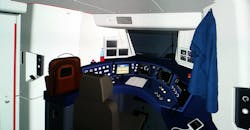Virtual Reality in Manufacturing
A press tour by Bombardier included a tour of Hennigsdorf, its largest site for design, manufacturing, and re-engineering and overhauls. There was also the opportunity to experience Bombardier’s use of virtual reality technology.
Between the initial product idea and the start of production, there is about two years’ worth of design taking place. Three-dimensional (3-D) visualization offers a real-size product representation, saving time and money.
An example for the DB S-Bahn illustrated how virtual reality improves the engineering process. The customer wanted a taller roof for more space within the train car. The roof was raised in each of the spaces by the door and was lower in the seated portions of the train. The customer could then be brought in and “walked” through the train to see what it felt like to be in the space, as opposed to building physical mock-ups.
Susanne Hellwig with Bombardier Transportation in the virtual reality center said while virtual reality isn’t meant to eliminate mock-ups, it allows them to postpone them to a later stage in the design process so there are not as many changes.
Walking through the virtual reality car, you could see the spatial relationships and see the color, textures of flooring and seats, and lighting of the interior. Not only can you view the interior, you can literally look inside every inch of the train to see every single component and assembly in the finished product.
On the S-Bahn train we viewed, there were 440,000 single pieces, down to every single cable and bolt. You can view cross sections of the train from the front, side, top or bottom and you can peel away the layers in real time. Components can be assembled and dismantled to see any potential problems.
Another use is looking at the impact on people riding the train or people maintaining the train. Human models can be manipulated in the space and the joints appear green, yellow or red to show the strain put on joints in whatever position the models are in. There were two examples with human models we saw, one as a passenger and one as a mechanic. The passenger was in a wheelchair and needed to push the emergency call button. The virtual space allowed us to see how the chair maneuvered to get to the button, how she would reach to the call button and what, if any, stress that put on joints. There was stress put on the arm to reach out and push a button, but as it’s a push and release, your arm doesn’t have to hold that position, so it’s not a problem.
As for the mechanic, there was a panel in the operator cab that would need to be removed to get at a certain component that requires fairly regular maintenance. To reach it and to hold the position long enough, it could show there was too much strain. However, with some design modification, there was a fix that allowed easier access to the space.
This was just one part of a tour but this segment really stood out. One is the reminder that we are in an amazing industry. Not only do we provide a valuable service — offering a lifeline for many — the most advanced technologies available are being employed to do it.
Another is that costs are rising and budgets are tightening. Bombardier President Laurent Troger began the press tour with an overview of the market and stressed how they have to focus on bringing products to market as quickly and economically as possible.
A few years ago I toured Bombardier Transportation’s prototype facility in Montreal. While there, one of the orders they were working on was for Bay Area Rapid Transit (BART). We weren’t able to take photos in the facility, but the work they do for the mock-up is beautiful. There were full-size, exact-replica mock-ups out of wood. And, it’s of every part of the rail car. If there’s a change after that point, that’s a lot of re-tooling of that intricate work.
It reminds me of when I’m talking to people at transit agencies and they all have a story of a rider asking for a "simple" change, like moving a bus stop to the other side of the street, or changing the fabric of a seat, or making a bus come every 15 minutes instead of every 18 minutes. Seems simple enough to the rider.
They may be different time and budget constraints facing the suppliers, but the implications are similar and this was one example in how the latest technologies are being used to meet those pressures.
Seeing an entire train car being peeled away inch by inch, from every angle, with every wire, harness, bolt and component visible is nothing short of amazing.
